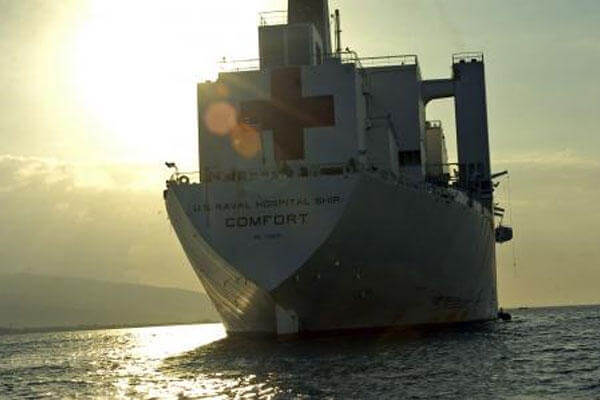MONTEREY, Calif. - A recent analysis of lighting life cycle costs aboard the USNS Comfort, conducted by students at the Naval Postgraduate School (NPS), revealed a lighting solution that could save taxpayers up to $6 million in as few as three years.
The Comfort is a 1,000-bed Military Sealift Command hospital ship. The vessel was originally built in 1977 as a commercial oil tanker and was converted by the Navy in 1986 for service with the Military Sealift Command.
“We have everything a 1,000-bed hospital would have, but additionally, we have a galley and the quarters that support a working staff of 2,200 people,” said USNS Comfort Chief Engineer Joseph Watts. “The Comfort is basically a giant, floating building.”
The Comfort and its crew of doctors, nurses and sailors participate in humanitarian assistance and disaster relief (HA/DR) operations and exercises, and were pivotal in support efforts during Haiti’s devastating 2010 earthquake.
Watts requested a life cycle lighting analysis of the Comfort in an attempt to reduce electrical, maintenance and disposal costs associated with shipboard lighting.
“Just keeping the lights on is quite a chore, we generate our own electricity at sea and plug into a public meter while in port. The bills are quite impressive. I was interested in reducing the cost and man hours necessary to keep the lights on,” said Watts.
NPS students explored the feasibility of replacing traditional fluorescent lighting aboard the Comfort with new LED lighting fixtures and bulbs. The Comfort uses approximately 14,000 24-inch bulbs and another 14,000 48-inch bulbs.
According to Watts, fluorescent bulbs must be replaced annually. The materials and maintenance costs associated with replacing some 28,000 bulbs can be daunting.
“If you wanted to change a few light bulbs in your own home, you wouldn’t have to take out a second mortgage, but what if the scope of the problem involved government purchases of tens of thousands of bulbs plus government employee maintenance staffing spread out over many years?” asked NPS Professor of Operations Research retired Navy Capt. Steve Pilnick.
In order to provide an accurate analysis, students compared a wide variety of lighting options that included both fluorescent and LED bulbs.
“In terms of looking at different lighting options, many venders did not provide very good information about how they determined bulb life and capabilities, so we had to be careful in our analysis to be sure that we were comparing apples to apples,” said analysis team member Navy Reserve Lt. Cmdr. John Goering.
But, students were not only concerned with finding a better bulb, they were tasked to find cost and energy efficient bulbs that could provide consistent lighting in the presence of radio frequency interference and harmonic distortion produced by the X-ray and CAT scan machines employed aboard the ship.
In addition to costs, students weighed the environmental impact of utilizing either fluorescent or LED lighting. Early analysis seemed to suggest that LED bulbs would provide a cost effective and more environmentally-sound alternative.
According to Watts, LED bulbs are cheaper over time, and because they do not contain hazardous materials, they are safer for the environment and do not require hazardous waste disposal.
Pilnick is hopeful that lessons learned aboard the Comfort will lead to further improvements throughout the fleet.
“The Navy benefits from this study, it provides the detailed cost-versus-benefit analysis necessary to meet mission requirements with tight budgets,” said Pilnick. “Military Sealift Command leadership was able to make an informed decision due to the work of government employees that understood the problem and were able to communicate a solution.”
The student-led lighting cost analysis was part of a distance learning capstone project completed in conjunction with NPS’ distance learning Master of Systems Analysis curriculum. The program is designed primarily to provide graduate level education to mid-grade naval officers whose career paths do not afford them the opportunity to conduct resident graduate studies at NPS.
“We focus our curriculum on practitioners and we build into our curriculum projects that are meaningful to our students,” said Pilnick. “Ninety-five percent of our students work on projects that come out of, or are sponsored by, organizations for which they are currently working.”
Goering’s career is indicative of the program’s approach. He was serving as the Comfort’s Assistant Port Engineer while taking part in the life cycle lighting analysis. He credits the program with not only providing his team with the solution to a complex problem, but with the opportunity to complete his graduate education as well.
“I was mobilized and sent to Afghanistan to serve as the Bagram Army Air Field land manager part way though the program. If the degree had not been offered in a distance learning format, I could not have got it done,” said Goering.
“In my current job as a life cycle manager, I utilize many of the techniques that were taught in the systems analysis curriculum. Areas like life cycle analysis and both trend and pattern analysis have been beneficial … [the curriculum] has helped me ask the right questions,” continued Goering.





























